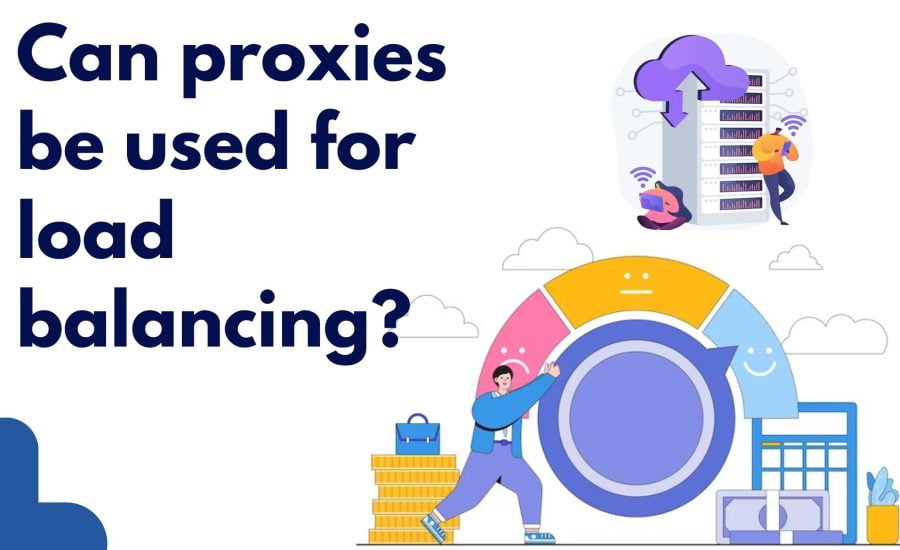What is proxy load balancing?
Proxy load balancing distributes incoming network traffic across multiple datacenter proxy servers and its uses to optimize performance and scalability. It improves availability by evenly distributing the workload and prevents any single server from being overloaded.
How do proxies help with load balancing in a network?
Datacenter proxies help with load balancing in a network by acting as intermediaries between clients and backend servers. They receive incoming traffic and distribute it across multiple servers based on predefined load-balancing algorithms or rules.
This ensures that the workload is evenly distributed, prevents server overload, and improves overall network performance and availability. Cheap datacenter proxies also provide additional benefits such as caching, session persistence, and traffic optimization, further enhancing the load-balancing capabilities in the network.
What advantages do proxies offer for load balancing compared to other methods?
Datacenter proxies offer several advantages for load balancing compared to other methods:
Enhanced Performance
Proxies can cache and serve frequently accessed content, reducing the load on backend servers and improving response times for clients.
Scalability
Our datacenter proxies enable horizontal scalability by allowing the addition of more proxy server use as the traffic load increases, ensuring seamless handling of growing demands.

Flexibility
Our cheap datacenter proxies can adapt to different load-balancing algorithms and rules, providing flexibility in managing traffic distribution based on factors like server health, geographic location, or client-specific requirements.
Security
Our cheap datacenter proxies act as a protective shield between clients and backend servers, adding an extra layer of security by concealing server information and mitigating DDoS attacks.
High Availability
Proxies distribute traffic across multiple backend servers, ensuring that if one server fails, others can handle the load, maintaining continuous service availability.
Session Persistence
Proxies can maintain user sessions during load balancing operations, ensuring uninterrupted user experience and data integrity.
Traffic Optimization
Proxies optimize traffic by compressing data, reducing bandwidth usage, and optimizing network connections, leading to improved overall network performance.
Simplified Management
Proxies provide centralized control and management of traffic routing, making it easier to monitor, analyze, and adjust load-balancing configurations as needed.
Overall, datacenter proxies offer a robust and versatile solution for load balancing, providing improved performance, scalability, security, and flexibility compared to alternative methods.
Can proxies maintain user sessions during load-balancing operations?
Yes, proxies can maintain user sessions during load-balancing operations. When load balancing is performed using our datacenter proxies, the user session information can be stored and synchronized across multiple backend servers.
This allows the proxy to route subsequent requests from the same user to the appropriate server that holds the user’s session data, ensuring continuity and preserving the session state throughout the load-balancing process.

How can the performance of proxies in load balancing be monitored and analyzed?
The performance of proxies in load balancing can be monitored and analyzed through various methods:
Traffic Monitoring
Network monitoring tools can capture and analyze the traffic passing through the proxies, providing insights into traffic patterns, bandwidth usage, and request/response times.
Server Health Monitoring
Monitoring the health and performance of backend servers can help identify any bottlenecks or issues that may impact the performance of proxies in load balancing. Metrics such as server CPU usage, memory utilization, and response times can be monitored.
Proxy Logs
Analyzing the logs generated by the proxies can provide valuable information about the number of requests handled, response times, error rates, and other relevant metrics. Log analysis tools can help identify patterns, anomalies, and potential performance issues.
Load Balancer Metrics
Load balancers often provide performance metrics specific to the load-balancing functionality. These metrics can include connection counts, server response times, error rates, and throughput, allowing for monitoring and analysis of the load-balancing performance.
Real-Time Monitoring
Utilizing real-time monitoring tools and dashboards can provide immediate visibility into the performance of proxies in load balancing, allowing for quick identification and resolution of any performance issues or bottlenecks.
Performance Testing
Conducting load and performance testing scenarios can help simulate different traffic loads and analyze how proxies handle the load balancing, providing insights into response times, throughput, and overall performance under various conditions.
By combining these monitoring and analysis methods, administrators can understand the performance of proxies in load balancing and make informed decisions to optimize and improve the load-balancing infrastructure.
How do proxies contribute to scalability and availability in load balancing?
Sure! Here’s a simplified explanation of how proxies contribute to scalability and availability in load balancing:
Handling More Traffic
Proxies allow you to add more servers easily. When the number of visitors or requests increases, you can add more proxy servers to distribute the workload efficiently, ensuring that your website or application can handle the increased traffic without slowing down.
Balancing the Workload
Proxies evenly distribute incoming requests across multiple servers. This prevents any single server from being overwhelmed, ensuring that each server shares the workload and operates efficiently. It helps maintain a smooth user experience even during high-traffic periods.
Monitoring Server Health
Proxies keep an eye on the health of servers. If a server becomes unavailable or starts performing poorly, the proxy can automatically redirect traffic to other healthy servers. This helps ensure that your website or application remains available and responsive, even if some servers encounter issues.
Handling Server Failures
Proxies are prepared for server failures. If a server goes down, the proxy can redirect incoming traffic to other functioning servers, minimizing disruptions and ensuring that your website or application stays up and running.
Maintaining User Sessions
Proxies are prepared for server failures. If a server goes down, the proxy can redirect incoming traffic to other functioning servers, minimizing disruptions and ensuring that your website or application stays up and running.
Proxies can keep track of user sessions during load balancing. When a user interacts with your website or application, the proxy ensures that their session information is preserved and passed on to the appropriate server. This helps maintain a seamless user experience, as users won’t be abruptly logged out or lose their progress during load-balancing operations.
What security considerations are important when using proxies for load balancing?
When using proxies for load balancing, keep these security considerations in mind:
Control Access
Make sure only authorized clients can access the proxy servers through proper authentication and authorization mechanisms.

Encrypt Communication
Use encryption protocols (like SSL/TLS) to secure the data transmitted between clients, proxies, and backend servers, protecting it from unauthorized access or tampering.
Secure Proxy Servers
Keep the proxy servers up to date with regular updates and patches, disable unnecessary services, and minimize potential attack vectors.
Why should you protect your privacy online? To know more about online privacy read this blog.
Monitor and Log
Implement monitoring and logging systems to identify any suspicious activities or potential security incidents, enabling quick response and resolution.
DDoS Protection
Protect the proxy infrastructure from distributed denial-of-service (DDoS) attacks by using techniques like rate limiting, traffic filtering, or specialized DDoS protection services. Our proxies prevent unexpected attacks on server by using a proxy server.
Secure Proxy Communication
Make sure the communication between the proxy servers and backend servers is also secured using encryption and appropriate authentication methods.
Regular Audits and Testing
Conduct periodic security audits and penetration testing to uncover vulnerabilities and enhance the overall security of the proxy infrastructure.
By considering these security measures, you can safeguard your load-balancing infrastructure effectively.
Conclusion
In conclusion, Proxiesforrent datacenter proxies can be used for load balancing. They are crucial in distributing incoming traffic across multiple backend servers, ensuring even workload distribution, improved performance, scalability, and high availability.
Advantages of proxiesforrent proxies such as enhanced performance, flexibility in traffic management, security measures, session persistence, and simplified management. By leveraging proxies for load balancing, organizations can optimize resource utilization, handle increased traffic demands, and provide a seamless user experience.



